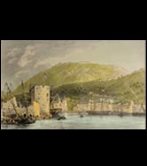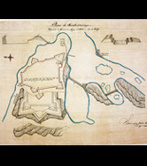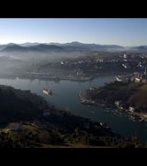Discord at the port of Pasaia
The extensive area of land granted by charter to the people of San Sebastián in the late 12th century (an area that stretched between the mouths of the rivers Bidasoa and the Oria, and from the coast to Navarra) has undergone a number of alterations over the course of the centuries, as a result of which it has diminished in size. These changes were not made equally throughout the area. Even today, a number of contentious areas still exist (such as Igeldo, Altza and Zubieta), while others have generated massive lawsuits that have never been entirely resolved. One such case is Pasaia and its bay.
The intensive trading and fishing that has gone on in San Sebastián ever since its earliest days, as well as the need to find supplies for the town (where there has never been a great deal of agricultural activity), meant that a suitable infrastructure was required to support it. Thus, Donostia had three harbours: Urumea, La Concha and Pasaia. The first, which specialised in river trading (the river was navigable as far as Hernani), was named after the nearby chapel of Santa Catalina. The "main port", La Concha, was originally a simple anchorage until, in 1440, a wharf was built beneath Urgull, by the wall. The harbour of Pasaia was the best of the three in terms of safety and capacity.
Thus, control of the natural anchorage of Pasaia became strategically important for the town, as large vessels could moor there safely. However, the pressure exerted by the town of San Sebastián on the riverside dwellers in the form of the lighthouse that was built at San Pedro, as well as the town’s control over supplies to coastal towns (Oiartzun, Errenteria, Pasaia and Lezo, where direct disembarkation for provisioning purposes was prohibited) were the source of numerous conflicts.
With lawsuits, Donostia always emerged victorious thanks to the mediaeval laws that granted the town complete jurisdiction over most of the bay, as well as shared jurisdiction over another large part of it. Disputes took place in the courts and hostility between the neighbourhoods involved sporadically erupted into violence. The situation worsened when, in the 16th century, the activities of the Atlantic companies were granted special importance in the bay of Pasaia. The high duties charged by San Sebastián were a permanent source of complaint in Errenteria, Oiartzun and Fuenterrabía (Hondarribia: even though the town stood on the Bidasoa, its jurisdiction covered San Juan – Donibane – and Lezo).
The inquiries that commenced in the 17th century in an attempt to redistribute power in the area were continually rejected. In 1770, Donibane gained independence from Hondarribia, and efforts were redoubled to remove the bay from San Sebastián's jurisdiction. The arrival of royal commissioner Vargas Ponce in the region resulted in a profound reorganisation of the territory. He even succeeded in incorporating lower Bidasoa into Navarra (including Lezo, which was under the jurisdiction of Hondarribia until 1812), though this project failed owing to the Napoleonic war. This erudite gentleman believed that the way to revitalise the port was to completely separate it from Donostia, both legally and geographically. As a consequence, in 1805 he ordered that a new municipality be founded called Pasaia, which would have jurisdiction over the bay (San Juan or Donibane and San Pedro, while in the second half of the 19th century, Antxo was urbanised by recovering the marshland). To alleviate the shortage of land and income of the recently-created municipality, it was allocated a large area of land that comprised much of the district of Altza. This resulted in a further 200 years of lawsuits over whether to carry out the project or not; the issue has still not been settled.




